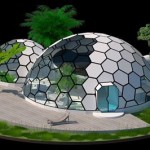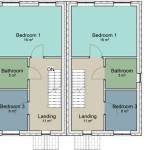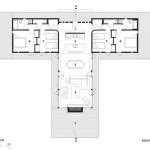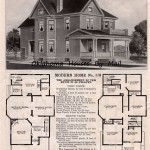A duplex house plan refers to a two-family residential building with two separate living units, typically side-by-side. Duplexes are common housing options in urban and suburban areas, offering both privacy and cost-efficiency for families or individuals seeking their own living spaces.
Duplex house plans often incorporate separate entrances, kitchens, and living areas for each unit, while sharing common structural elements such as walls, roof, and utilities. This arrangement provides a sense of independence and individuality for the occupants, while also maximizing space utilization and reducing construction costs.
As we delve into the details of duplex house plans, we will explore the various design considerations, benefits, and challenges associated with this unique type of residential architecture.
When considering a duplex house plan, it’s important to be aware of key points that will impact the design and functionality of your home.
- Separate entrances
- Independent living units
- Shared structural elements
- Cost efficiency
- Privacy and individuality
- Design considerations
- Benefits and challenges
- Space utilization
- Architectural uniqueness
Understanding these factors will help ensure your duplex house plan meets your specific needs and requirements.
Separate entrances
Separate entrances are a crucial aspect of duplex house plans, providing privacy and independence for each living unit. These entrances can be designed in various ways to suit different preferences and architectural styles.
One common approach is to have separate entrances on opposite sides of the building. This arrangement allows each unit to have its own private outdoor space, such as a patio or porch. It also minimizes noise and disturbance between the two units.
Another option is to have the entrances located on the front of the building, with each unit having its own dedicated entryway. This design can create a more traditional and symmetrical appearance, while also providing convenient access for both units.
In some cases, duplexes may have a shared entrance that leads to a common foyer or hallway. From there, each unit has its own separate entrance door. This design can be space-efficient and cost-effective, but it may compromise privacy and sound insulation between the units.
When considering separate entrances for a duplex house plan, it’s important to factor in factors such as privacy, security, accessibility, and overall architectural aesthetics. Careful planning and design can ensure that each unit has its own distinct and functional entrance that meets the needs of the occupants.
Independent living units
Independent living units are a defining characteristic of duplex house plans. Each unit within a duplex is designed to function as a self-contained living space, providing occupants with privacy, autonomy, and the ability to live independently.
These units typically include all the essential amenities of a single-family home, such as a kitchen, bathroom, living room, and bedrooms. They may also have their own laundry facilities, outdoor space, and separate utility meters. This level of independence allows each unit to operate as its own household, with occupants having control over their own living arrangements, schedules, and expenses.
The separation between units extends beyond physical space. Duplex house plans often incorporate soundproofing measures to minimize noise transfer between units, ensuring privacy and tranquility for each occupant. Additionally, each unit may have its own dedicated parking space or garage, further enhancing the sense of independence and convenience.
The concept of independent living units in duplex house plans is particularly appealing to a wide range of individuals and families. They offer a balance between privacy and community, making them suitable for extended families, multi-generational living arrangements, or individuals seeking a sense of autonomy while still being part of a shared living space.
Shared structural elements
In addition to separate entrances and independent living units, duplex house plans also incorporate shared structural elements that contribute to the overall efficiency and integrity of the building.
- Walls
Duplexes typically share common walls between the two units. These walls provide structural support for both units and help to minimize noise transfer. They can be constructed using various materials, such as wood, concrete, or brick, depending on the architectural design and local building codes.
- Roof
Duplexes often have a single roof structure that covers both units. This shared roof helps to reduce construction costs and provides a more cohesivefor the building. It is typically designed to withstand the specific weather conditions of the region where the duplex is located and may incorporate features such as gutters, downspouts, and proper insulation.
- Foundation
Duplexes share a common foundation that supports the entire structure. This foundation is typically made of concrete and is designed to distribute the weight of the building evenly. A strong foundation is essential for the stability and durability of the duplex.
- Utilities
In some cases, duplexes may share certain utilities, such as water and sewer lines. This can help to reduce the cost of installing and maintaining these utilities. However, it is important to ensure that the utilities are properly sized and maintained to meet the needs of both units.
By carefully planning and designing the shared structural elements, duplex house plans can achieve both efficiency and functionality, providing a comfortable and durable living environment for multiple families or individuals.
Cost efficiency
Cost efficiency is a significant advantage associated with duplex house plans. Constructing a duplex can be more cost-effective compared to building two separate houses, as it involves sharing certain structural elements and resources.
One of the key cost-saving factors is the shared foundation and roof. By combining these structural components, builders can reduce the amount of materials and labor required, leading to lower construction costs. Additionally, the shared walls between the units eliminate the need for exterior walls on that side of the building, further reducing material and construction expenses.
Another cost-saving aspect of duplex house plans is the potential for shared utility systems. In some cases, it may be possible to install a single utility system, such as water and sewer lines, for both units. This can significantly reduce the cost of installing and maintaining these essential services compared to having separate systems for each unit.
Furthermore, the efficient use of space in duplex house plans contributes to cost savings. By vertically stacking the units, duplexes maximize the use of land, reducing the overall footprint of the building. This can be particularly advantageous in urban areas where land is scarce and expensive.
Overall, the cost efficiency of duplex house plans makes them an attractive option for individuals and families seeking an affordable and practical housing solution.
Privacy and individuality
Privacy and individuality are key considerations in duplex house plans. Each unit is designed to provide a sense of independence and self-containment, allowing occupants to enjoy their own private living spaces.
Separate entrances are a crucial aspect of duplex house plans in ensuring privacy. Each unit has its own dedicated entrance, providing occupants with the freedom to come and go without disturbing the other unit. This separation also minimizes the potential for noise and disturbances between the units.
The interior layout of duplex house plans is designed to maximize privacy and minimize shared spaces. Each unit typically has its own kitchen, bathroom, living areas, and bedrooms. This allows occupants to have their own private spaces for cooking, sleeping, and relaxing without having to share these amenities with the other unit.
In addition to physical separation, duplex house plans often incorporate soundproofing measures to minimize noise transfer between units. Walls and floors may be constructed using sound-dampening materials, and windows and doors may be fitted with noise-reducing features. This helps to ensure that occupants can enjoy peace and quiet within their own units.
Overall, duplex house plans are designed to provide a high level of privacy and individuality for each unit. This makes them an attractive option for families, individuals, and multi-generational households seeking independent living arrangements while still being part of a shared building.
Design considerations
When designing a duplex house plan, several key considerations should be taken into account to ensure the functionality, comfort, and aesthetic appeal of the building. These considerations include:
- Space allocation
Space allocation is crucial in duplex house plans to ensure that each unit has adequate space for the desired number of bedrooms, bathrooms, living areas, and other amenities. Careful planning is required to maximize space utilization while maintaining a comfortable and functional layout for both units.
- Natural lighting
Natural lighting is an important factor to consider in duplex house plans. Windows and skylights should be strategically placed to allow ample natural light into each unit, reducing the need for artificial lighting and creating a bright and inviting living environment.
- Privacy and noise control
Privacy and noise control are essential considerations in duplex house plans. The design should incorporate measures to minimize noise transfer between units, such as soundproofing materials in walls and floors, and separate entrances to ensure privacy and minimize disturbances.
- Exterior design
The exterior design of a duplex house plan should complement the surrounding environment and architectural style. The choice of materials, colors, and finishes should be carefully considered to create a cohesive and aesthetically pleasing appearance that enhances the overall curb appeal of the property.
By carefully considering these design considerations, architects and homeowners can create duplex house plans that meet the specific needs and preferences of the occupants, while also ensuring a functional, comfortable, and visually appealing living environment.
Benefits and challenges
Duplex house plans offer a range of benefits and challenges. Understanding these factors can help individuals and families make informed decisions about whether a duplex is the right housing option for them.
- Cost-effectiveness
Duplex house plans can be more cost-effective compared to building two separate houses. By sharing structural elements and resources, such as the foundation, roof, and walls, duplexes can reduce construction costs. Additionally, the efficient use of space in duplexes can lead to lower land acquisition costs, particularly in urban areas where land is scarce and expensive.
- Privacy and independence
Duplex house plans provide a high level of privacy and independence for each unit. Separate entrances, soundproofing measures, and dedicated outdoor spaces ensure that occupants can enjoy their own private living arrangements without disturbances from the other unit. This makes duplexes an attractive option for families, individuals, and multi-generational households seeking independent living spaces.
- Rental income potential
For investors or homeowners looking to generate rental income, duplex house plans offer the potential for dual rental streams. Each unit can be rented out separately, providing a steady source of income. This can be particularly beneficial in areas with high rental demand and can help offset the costs of owning and maintaining the property.
- Flexibility and adaptability
Duplex house plans offer flexibility and adaptability in terms of design and use. The units can be customized to meet the specific needs and preferences of the occupants, whether it’s for a single family, extended family, or multi-generational living arrangements. Additionally, duplexes can be adapted to accommodate changing needs over time, such as the addition of an accessory dwelling unit or home office space.
Along with these benefits, duplex house plans also come with certain challenges that should be considered:
- Shared responsibility
In a duplex house plan, the owners or occupants share responsibility for the maintenance and upkeep of the common areas, such as the roof, foundation, and exterior walls. This shared responsibility requires cooperation and clear agreements between the parties involved.
- Potential for disputes
As with any shared living arrangement, there is the potential for disputes between the occupants of a duplex. These disputes may arise over issues such as noise, privacy, maintenance responsibilities, or shared expenses. Clear communication and established rules can help minimize the risk of disputes.
- Limited outdoor space
Depending on the design of the duplex house plan, outdoor space may be limited, especially in urban areas where land is scarce. This can be a consideration for individuals or families who desire a larger outdoor area for recreation or gardening.
- Architectural constraints
The shared structural elements in a duplex house plan can impose certain architectural constraints on the design of each unit. For example, the placement of windows and doors may be limited by the need to maintain structural integrity and ensure privacy between the units.
By carefully weighing the benefits and challenges, individuals and families can make informed decisions about whether a duplex house plan meets their specific needs and preferences. With proper planning, communication, and maintenance, duplexes can provide a cost-effective, private, and adaptable housing solution for a variety of living arrangements.
Space utilization
Space utilization is a crucial aspect of duplex house plans, as it directly impacts the functionality, comfort, and overall livability of each unit. Duplexes, by their very nature, require careful planning to maximize space while maintaining privacy and independence for each occupant.
- Vertical stacking
One of the primary ways duplex house plans achieve efficient space utilization is through vertical stacking. By placing the units one above the other, duplexes reduce the overall footprint of the building while maximizing the usable living space. This vertical stacking is particularly advantageous in urban areas where land is scarce and expensive.
- Shared walls
Duplex house plans utilize shared walls between the units, eliminating the need for exterior walls on those sides. This clever design strategy not only reduces construction costs but also maximizes space utilization by minimizing the overall perimeter of the building. The shared walls provide structural support and sound insulation, ensuring privacy and comfort for both units.
- Compact layouts
To optimize space further, duplex house plans often incorporate compact and efficient layouts within each unit. Rooms are designed to be functional and well-proportioned, avoiding wasted space. Open-plan living areas and clever storage solutions help create a sense of spaciousness and maximize the usability of each square foot.
- Multipurpose spaces
To enhance space utilization even further, duplex house plans may incorporate multipurpose spaces that serve multiple functions. For example, a loft area could be used as a guest room, home office, or additional living space. Built-in storage units and convertible furniture can also maximize space and provide flexibility to accommodate changing needs.
By carefully considering and implementing these space utilization techniques, duplex house plans can create comfortable and functional living environments that make the most of the available space. Architects and homeowners can work together to design duplexes that meet the specific needs and preferences of the occupants, ensuring that each unit feels spacious, comfortable, and tailored to their lifestyle.
Architectural uniqueness
Duplex house plans offer a unique blend of architectural styles and design elements that set them apart from traditional single-family homes. Their distinct features and configurations create a visually appealing and practical living environment.
- Vertical asymmetry
One of the striking architectural features of duplex house plans is their vertical asymmetry. The units are stacked one above the other, creating a dynamic and visually interesting facade. This asymmetry breaks the monotony of traditional symmetrical designs and adds character to the building’s exterior.
- Shared and distinct entrances
Duplex house plans typically incorporate separate entrances for each unit, ensuring privacy and independence for the occupants. These entrances can be designed in various styles, from simple and functional to grand and elaborate. The contrast between the shared exterior and the distinct entrances creates a sense of individuality and uniqueness.
- Mix of materials and textures
Duplex house plans often utilize a combination of materials and textures to enhance their architectural appeal. Brick, stone, wood, and stucco are commonly used to create a visually rich and textured exterior. The interplay of different materials adds depth and dimension to the facade, making each duplex house plan a unique work of architecture.
- Rooflines and dormers
The rooflines of duplex house plans can vary greatly, from simple gable roofs to more complex hip and mansard roofs. Dormers, small windows that project from the roof, are often incorporated to add architectural interest and provide additional natural light to the upper unit. The combination of different rooflines and dormers creates a visually dynamic and distinctive exterior.
The architectural uniqueness of duplex house plans extends beyond their external appearance. The interior layouts can also be customized to meet the specific needs and preferences of the occupants. By combining these unique architectural features with thoughtful interior design, duplex house plans offer a truly one-of-a-kind living experience.










Related Posts








